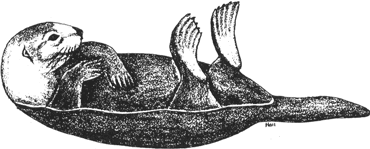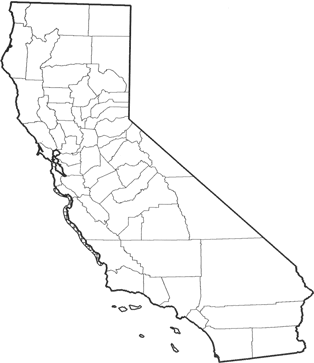
Sea Otter
Distribution, Abundance, and Seasonality
Sea otters are found in nearshore marine environments of California from Ano Nuevo, San Mateo Co. to Point Sal, Santa Barbara Co. Maximum densities in California occur at the periphery of the range, where food is plentiful. An average of 12 sea otters per mi? (2.6 km?) was reported throughout the central, established range in California by Wild and Ames (1974). Canopies of giant kelp and bull kelp provide important rafting and feeding areas (Miller 1974). Sea otters also forage regularly on clams and crabs in areas of sandy bottom habitat (Wild and Ames 1974). Population densities in these sandy areas are lower than in more productive rocky-bottom habitats.

Range Map
Specific Habitat Requirements
Feeding: Feed almost exclusively on marine invertebrates. They are opportunistic foragers, and eat mostly abalones and sea urchins, crabs, and clams in California (Wild and Ames 1974). Other food items in California include snails, mussels, scallops, chitons, barnacles, squids, octopuses, and starfishes (Miller 1974). Most feeding in California observed to occur at 1.5 to 12.2 m (5-40 ft) depths (Miller 1974). In captivity, consume 15-35% of body weight in food daily (Lensink 1962).
Cover: Frequent nearshore waters adjacent to rocky coasts, near points of land, or large bays where kelp beds occur. Often seen sleeping and diving for food in, or near, kelp beds (Kenyon 1969). Often pull one, or more, strands of kelp over body to remain stationary before resting and sleeping (Kenyon 1969). Also raft in open waters off sandy beaches to feed.
Reproduction: No births have been witnessed, but observations suggest births occur on intertidal reefs, and in water (Sandegren et al. 1973, Jameson 1983).
Water: Good quality, nearshore marine water, free of oil contaminants, is required to protect the insulation property of the fur.
Pattern: Optimal habitats include rocky substrates with ample interstices, where invertebrates can live out of reach of the sea otters. These areas provide a continuing source of food, as individuals move out and become available. Kelp beds also provide cover from high surf and predators.
Species Life History
Activity Patterns: Active yearlong in circadian pattern. Active day or night, with peak feeding in early morning and late afternoon (Fisher 1939).
Seasonal Movements / Migration: Non-migratory. Males at range peripheries move seasonally in relation to peaks in breeding activity (Kenyon 1969, Wendell et al. 1984). Females make fewer movements than males.
Home Range: Loughlin (1980) estimated females had home ranges of about 80 ha (198 ac), and territorial males had home ranges of about 35 ha (86 ac).
Territory: Mostly expressed weakly. However, in California, some males leave rafts of males and establish territories adjacent to, or including, rafting areas of females. No other males are allowed to rest in these territories. Females are allowed into these territories, subject to attempts at copulation. These male territories are congruent with home ranges, and smaller than those of nonterritorial males (Loughlin 1980).
Reproduction: In California, pups are born year-round, with a peak December through March (Wild and Ames 1974). Gestation period estimated to be 4-6 mo., including delayed implantation of undetermined length (Loughlin et al. 1981). A single pup born, which is dependent upon the female for 6-7 mo (Wendell et al. 1984). About 40% of females are mature sexually at 5 yr, and all are after 6 yr (Kenyon 1969, Estes 1980).
Niche: Populations of sea urchins, abalones, clams, and crabs can be reduced by sea otters in California to levels that will not support sport or commercial harvest (Miller 1974). Predation, other than by humans, is not important in sea otter population dynamics, according to Kenyon (1969). However, 9-15%, or more, of deaths recorded in California from 1968 through 1979 were attributed to the great white shark (Ames and Morejohn 1980).
Sources & References
California Department of Fish and Game, 1999.
California's Wildlife, Sacramento, CA.
Written by: D. Zeiner, reviewed by: R. Hardy, F. Wendell, J. Ames, edited by: W. Grenfell, Jr.
Ames, J. A., and G. V. Morejohn. 1980. Evidence of white shark, Carcharadon carcharias, attacks on sea otters, Enhydra lutris. Calif. Fish and Game 66:196-209. Estes, J. A. 1980. Enhydra lutris. Mammal. Species No. 133. 8pp. Fisher, E. M. 1939. Habits of the southern sea otter. J. Mammal. 20:21-36. Jameson, R. J. 1983. Evidence of birth of a sea otter on land in central California. Calif. Fish and Game 69:122-123. Kenyon, K. W. 1969. The sea otter in the Eastern Pacific Ocean. USDI, North Amer. Fauna No. 68. 352pp. Lensink, C. J. 1962. The history and status of sea otters in Alaska. Ph.D. Diss., Purdue Univ., Lafayette, IN. 216pp. Loughlin, T. R. 1980. Home range and territoriality of sea otters near Monterey, California. J. Wildl. Manage. 44:576-582. Loughlin, T. R., J. A. Ames, and J. E. Vandevere. 1981. Annual reproduction, dependency period, and apparent gestation period in two California sea otters, Enhydra lutris. NOAA Fisheries Bull. 79:347-349. Miller, D. J. 1974. The sea otter, Enhydra lutris, it's life history, taxonomic status and some ecological relationships. Calif. Dept. Fish and Game, Sacramento. Marine Leafl. No. 7. 13pp. Sandegren, F. E., E. W. Chu, and J. E. Vandevere. 1973. Maternal behavior in the California sea otter. J. Mammal. 54:668-679. Wendell, F. E., J. A. Ames, and R. A. Hardy. 1984. Pup dependency period and length of reproductive cycle: estimates from observations of tagged sea otters, Enhydrea lutris, in California. Calif. Fish and Game 70:89-100. Wild, P. W., and J. A. Ames. 1974. A report on the sea otter, Enhydra lutris L., in California. Calif. Dep. Fish and Game Mar. Resour. Tech. Rep. No. 20. 94pp.
California Animal Facts | California's Wildlife